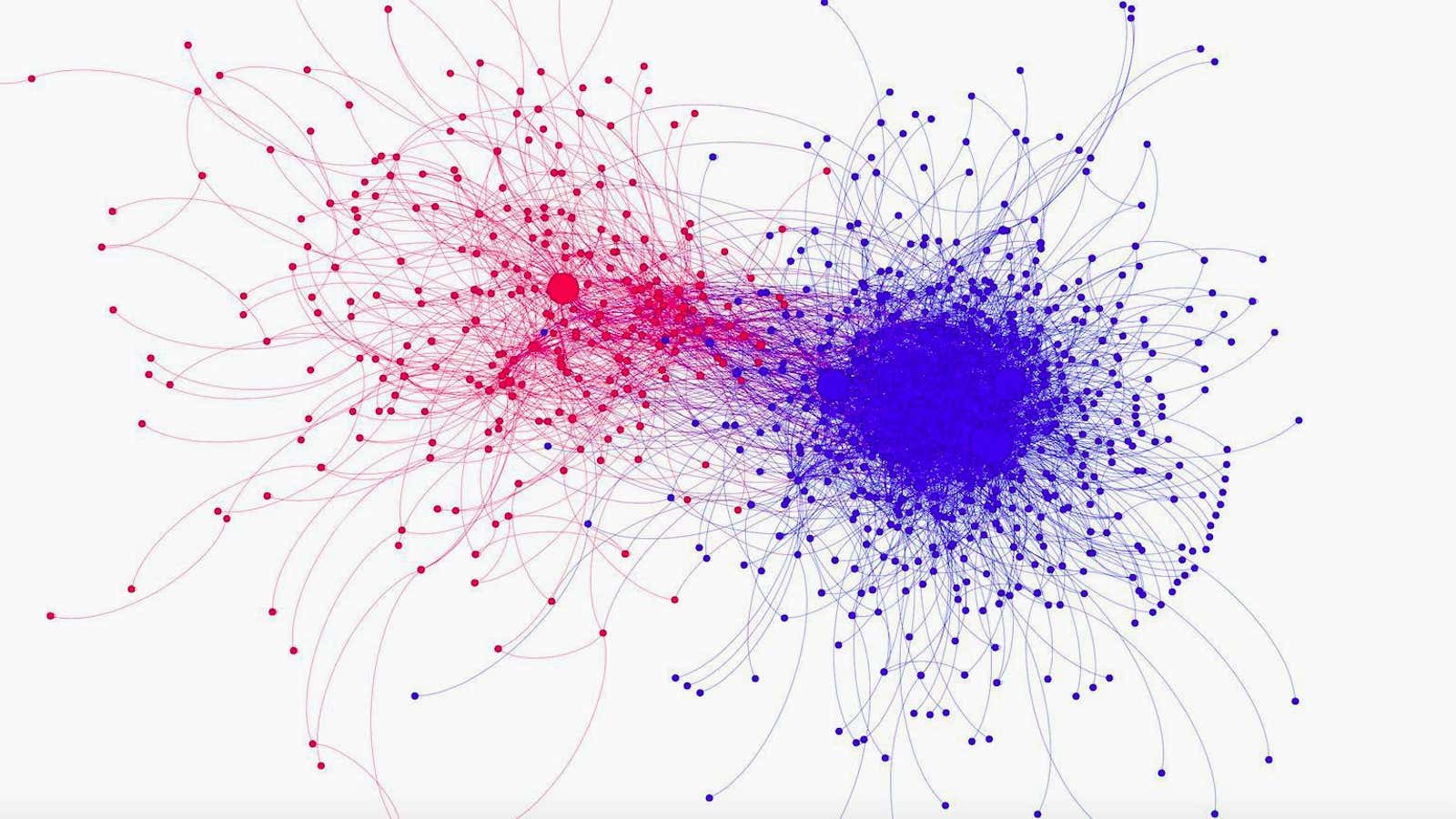After prosecutor Robert McCulloch announced the Ferguson grand jury’s decision not to indict Officer Darren Wilson for the shooting of Michael Brown, a night of clashes between police and protesters produced burning police cars, blocked highways, and automatic gunfire. Amid all the unrest, is it possible to get a clear look at some of the racial and political tensions that underlie the Ferguson conflict?
I studied this question using a platform which has has played a major role throughout events in Ferguson: Twitter. Twitter has been used to disseminate live (and sometimes inaccurate) information about Ferguson, organize protests, and even to cyberattack the KKK. In the days before the no-indictment decision, I collected a sample of more than 200,000 tweets related to Ferguson, and they painted a stark picture of how divided people were.
In the image at the top, each point is one of the most talkative tweeters, and two points are connected if one mentions the other: in essence, the image depicts the social network of who talks to whom. It shows two clearly divided groups[1].
Who are these groups? Group membership is strongly connected with political party: tweeters who describe themselves as “conservative” (or using similar adjectives) are disproportionately likely to be in the red group, and tweeters who describe themselves as “liberal” are disproportionately likely to be in the blue group. Group membership is also connected with race: tweeters whose profiles contain “African-American”, or similar adjectives, are far more likely to be in the blue group.
So, when it comes to Ferguson, two groups with very different political and racial backgrounds ignore each other. This seems likely to cause problems, and in fact it does. For one thing, the two groups think drastically different things. Here are the most common things retweeted by each group:
The red group says they would feel safer meeting Darren Wilson than Michael Brown, and says that Brown was armed when he was shot; the blue group sarcastically contrasts Darren Wilson with the unarmed Michael Brown. The red group talks about mob justice and race baiting; the blue group talks about breaking the system. The red group blames Obama for exacerbating tensions and forcing the Missouri governor into declaring a state of emergency; the blue group says the state of emergency must not be used to violate human rights.
So maybe if everyone would just talk to each other they would get along? Not necessarily: when the red and blue group did talk, it often wasn’t pretty. Consider the things said by members of the red group to one of the most influential members of the blue group – DeRay Mckesson, a school administrator who has played a central role in organizing protests. They described him as a “commie boy” who spread hate (like the “democrats, the blacks, and the left…the new KKK”), saw “value in racist drivel”, was armed with “guns and Molotov cocktails”, and should get his “meds adjusted”.
So we have two groups of people who rarely communicate, have very different backgrounds, think drastically different things, and often spray vitriol at each other when they do talk. Previous studies of Twitter have found similar echo chambers, the Israel-Palestine conflict offering one representative example. It is unclear to what extent Twitter merely reflects social divisions as opposed to causing them; I find it unlikely that Mckesson and the red tweeters would be friends if they met over beers. But even this preliminary analysis does not bode well for the possibility of reconciliation.
[1] It is worth noting that one can always split groups down further and the appropriate number of groups is often debated. In this case, when we split groups further, the red group remains a single group but the blue group, which is larger, splits into multiple groups.
